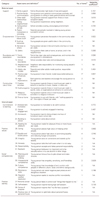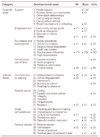References
1. Lee MS. Korean Association of Smoking and Health (KASH). Development of youth smoking prevention program in Korea. The 2002 seminar proceedings of Korean Association of Smoking and Health in collaboration with WHO: development of youth smoking prevention program 2002. Seoul: Korean Association of Smoking and Health;
2. World Health Organization. Skills for health: skills-based health education including life skills: an important component of a child-friendly/health-promoting school 2003. Geneva: World Health Organization;
3. Gerstein DR, Green LW, eds. Preventing drug abuse: what do we know? 1993. Washington DC: National Academy Press;
4. Benson PL. All kids are our kids 1997. San Francisco: Jossey-Bass Publishers Inc;
5. Leffert N, Benson PL, Scales PC, Sharma AR, Drake DR, Blyth DA. Developmental assets: measurement and prediction of risk behaviors among adolescents. Appl Dev Sci 1998. 2209–230.
6. Scales PC. The role of family support programs in building developmental assets among young adolescents: a national survey of services and staff training needs. Child Welfare 1997. 76611–635.
7. Benson PL, Scales PC, Leffert N, Roehlkepartain EC. A fragile foundation: the states of developmental assets among american youth 1999. Minneapolis: Search Institute;
8. Scales PC. Reducing risks and building developmental assets: essential actions for promoting adolescent health. J Sch Health 1999. 69113–119.
9. Scales PC. Building students' developmental assets to promote health and school success. Clearing House 2000. 7484–88.
10. Scales PC, Benson PL, Leffert N, Blyth DA. Contribution of developmental assets to the prediction of thriving among adolescents. Appl Dev Sci 2000. 427–46.
11. French SA, Leffert N, Story M, Neumark-Sztainer D, Hannan P, Benson PL. Adolescent binge/purge and weight loss behaviors: associations with developmental assets. J Adolesc Health 2001. 28211–221.
12. Scales PC, Benson PL, Roehlkepartain EC, Sesma A Jr, van Dulmen M. The role of developmental assets in predicting academic achievement: a longitudinal study. J Adolesc 2006. 29691–708.
13. Oman RF, Vesely SK, McLeroy KR, Harris-Wyatt V, Aspy CB, Rodine S, Marshall L. Reliability and validity of the youth asset survey (YAS). J Adolesc Health 2002. 31247–255.
14. Atkins LA, Oman RF, Vesely SK, Aspy CB, McLeroy K. Adolescent tobacco use: the protective effects of developmental assets. Am J Health Promot 2002. 16198–205.
15. Murphey DA, Lamonda KH, Carney JK, Duncan P. Relationships of a brief measure of youth assets to health-promoting and risk behaviors. J Adolesc Health 2004. 34184–191.
16. Zullig KJ, Ward RM, King KA, Patton JM, Murray KA. Testing the feasibility of developmental asset measures on college students to guide health promotion efforts. Assessment 2009. 1631–42.
18. Lee MS. Developmental assets among Korean youth. Health Soc Sci 2005. 1847–72.
19. Lee MS. Youth health-related behaviors among ninth grade students. J Korean Soc Matern Child Health 2006. 1040–57.
20. Lee MS. The impact of positive peer influence, restraint, social competencies and self-esteem on health risk behaviors of Korean youth. Health Soc Sci 2003. 14317–341.
21. Lee MS. Developmental assets: the protective effects on health risk behaviors among Korean adolescents. J Korean Soc Health Educ Promot 2005. 22137–154.
22. Yoo SK. Differences in risk factors and protective factors between male and female delinquent adolescents. Korean J Educ Psychol 2002. 16201–217.
23. Mun SM, Hwang YS. Effects of internal developmental assets programs on internal developmental assets high school girl students. Korean J Educ Psychol 2005. 19577–594.
24. Korea Center for Disease Control and Prevention. Major health issues in Korea: the results of Korea National Health and Nutrition Examination Surveys (NHANES) and Korea youth risk behavior web-based survey. Symposium for national health investment and chronic diseases control 2007. Seoul: Ministry of Health & Welfare, Korea Center for Disease Control and Prevention;
25. Kwak KJ. A review of researches of the impact of computer game and children's and adolescent's development. Korean J Psychol Soc Issues 2004. 10147–175.
26. Kwon JH, Lee EH. Predicting game addiction in adolescents: an application of discriminant function analysis. Korean J Health Psychol 2005. 1095–112.
27. Lee DH, Choi YM, Cho SC, Lee JH, Shin MS, Lee DW, Kim BS, Kim BN. Relationship between adolescent internet addiction and depression, impulsivity, and obsessive-compulsivity. J Child Adolesc Psychiatry 2006. 1710–18.
28. Lee YK, Chae KM. Relationship of computer game addiction and social relationship, adjustment of adolescent. Korean J Clin Psychol 2006. 25711–726.
29. Seo BD, Choi YH. Impulsivity and self-efficacy according to internet addiction. J Korean Acad Community Health Nurs 2008. 19310–316.
30. Jung HW, Oh SD. The difference between aggression and impulsiveness according to state of internet addiction of a vocational high school students in a rural area. Korean J Couns 2008. 9601–614.
31. Kim MS. The prevalence of depression of middle school students in a city, and the effect of depression on the school adjustment. Korean J Couns 2008. 9645–658.
32. Institute of Health Promotion Research. School-Based Prevention Project (SBPP) evaluation student survey 1994. Vancouver: Institute of Health Promotion Research, University of British Columbia;
33. Kann L, Kinchen SA, Williams BI, Ross JG, Lowry R, Grunbaum JA, Kolbe LJ. State and Local YRBSS Coodinators. Youth Risk Behavior Surveillance System. Youth risk behavior surveillance: United States, 1999. MMWR CDC Surveill Summ 2000. 491–32.
34. Botvin GJ, Eng A. The efficacy of a multicomponent approach to the prevention of cigarette smoking. Prev Med 1982. 11199–211.
35. Botvin GJ, Griffin KW, Diaz T, Scheier LM, Williams C, Epstein JA. Preventing illicit drug use in adolescents: long-term followup data from a randomized control trial of a school population. Addict Behav 2000. 25769–774.








